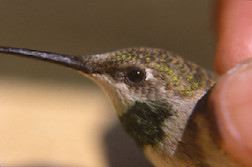|
home: www.rubythroat.org |
|
|
home: www.rubythroat.org |
|

From 27 July 1984 through Autumn 2007, a total of 3,614 Ruby-throated Hummingbirds (Archilochus colubris) have been banded and color-marked at Hilton Pond Center for Piedmont Natural History near York, South Carolina, USA. These birds have provided interesting and scientifically important information about Ruby-throated Hummingbird (RTHU) natural history.
For a closer look at some of the research results conducted as part of Operation RubyThroat, click on the charts below.
Chart 1--Unbanded Ruby-throated Hummingbirds begin to arrive at Hilton Pond Center in late March, show several peaks during spring and summer, and disappear by mid-October (through 2006).
Chart 2--Since 1984, an average of nearly 168 Ruby-throated Hummingbirds have been banded annually at Hilton Pond Center; the highest year was 2005 with 226 new RTHUs (through 2006).
Chart 3--In 23 years of banding Ruby-throated Hummingbirds at Hilton Pond Center, nearly half of all birds captured have been recently fledged (Hatch Year) males (through 2006).
Chart 4--Of the 3,246 Ruby-throated Hummingbirds banded at Hilton Pond Center prior to 2006 season, 377 returned in at least one later year--a significantly high site fidelity rate of 11.6%. Different age and sex classes showed very different return rates (includes birds banded through 2005 and returns through 2006).
Chart 5--Of the 3,410 Ruby-throated Hummingbirds banded through 2006 at Hilton Pond Center, very few have been encountered elsewhere. One was found dead at a feeder in Clover, South Carolina USA the spring after it was banded; Clover is about 10 air miles from Hilton Pond Center.
Chart 6--A recently fledged (Hatch-Year) male Ruby-throated Hummingbird was retrapped by bander Bob Sargent near Atlanta, Georgia USA 10 days after it was banded at Hilton Pond in Autumn 1991. This was the first Ruby-throated Hummingbird ever recaptured and released more than 10 miles away from its original banding site.
Chart 7--A Ruby-throated Hummingbird banded at Hilton Pond Center and color-marked with green dye on its upper breast and throat was seen at a feeder in western Louisiana in 1997. Other distant sightings of color-marked RTHUs include: One retrapped near Atlanta, Georgia in 1991; one near Mobile, Alabama in 2000; one found dead at Thomaston, Alabama in 2006; and another reportedly observed (but unconfirmed) at a feeder east of Charlotte, North Carolina in Sep 1999.
Chart 8--New bandings of Ruby-throated Hummingbird adults begin as early as 27 Mar and continue as late as 17 Sep; the earliest juvenile was banded on 9 Jun and the latest on 18 Oct.
RTHUs banded at Hilton Pond Center have yielded much more data that are still under analysis. Some of the results will be published in scientific journals (see, for example, ) and also will appear on the Web sites Operation RubyThroat and/or Hilton Pond Center. Check back often for new information about hummingbirds that can be learned only through banding, color-marking, and releasing them unharmed.
Back to Color-marking Hummingbirds; return to Hummingbird Banding Main Page
Up to Top of Page
|
Make direct donations on-line through
Network for Good: |
 |
|
LIKE TO SHOP ON-LINE?
Donate a portion of your purchase price from 500+ top on-line stores via iGive: |
|
|
Use your PayPal account
to make direct donations: |
|
|
|
Share Your Hummingbird Experiences Through "Hummingbird Hobnob" |
 |
Operation |
|
|